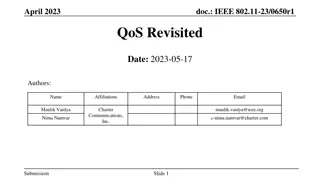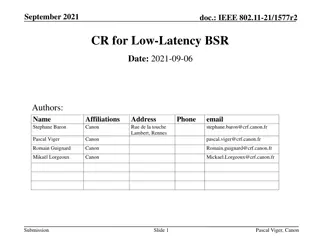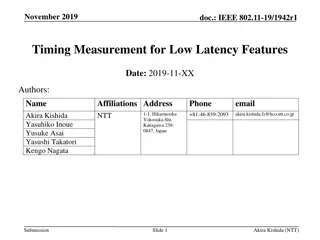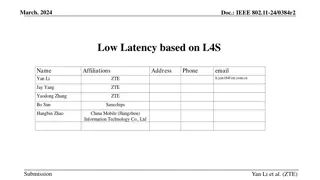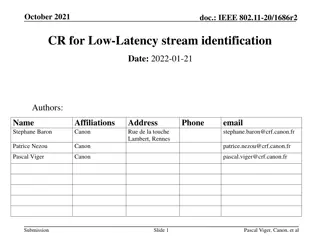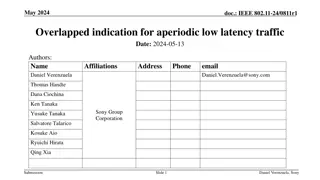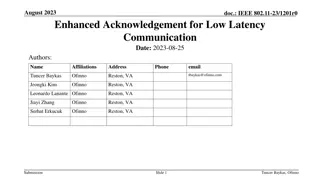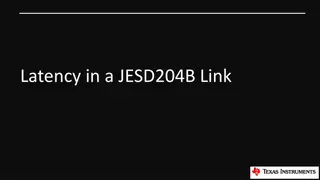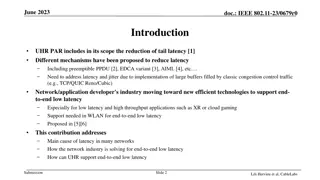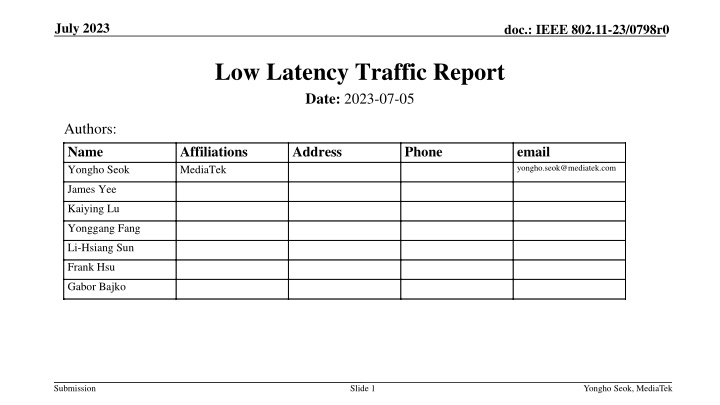
IEEE 802.11-23 Low Latency Traffic Report Analysis
This document presents a detailed discussion on the procedure for low latency traffic reports within the IEEE 802.11-23 standard. It covers how an Access Point (AP) and Station (STA) can preempt channel access based on low latency traffic report signaling. The proposal involves improving low latency data for both APs and STAs through a specific procedure utilizing uplink OFDMA random access.
Download Presentation

Please find below an Image/Link to download the presentation.
The content on the website is provided AS IS for your information and personal use only. It may not be sold, licensed, or shared on other websites without obtaining consent from the author. If you encounter any issues during the download, it is possible that the publisher has removed the file from their server.
You are allowed to download the files provided on this website for personal or commercial use, subject to the condition that they are used lawfully. All files are the property of their respective owners.
The content on the website is provided AS IS for your information and personal use only. It may not be sold, licensed, or shared on other websites without obtaining consent from the author.
E N D
Presentation Transcript
July 2023 doc.: IEEE 802.11-23/0798r0 Low Latency Traffic Report Date: 2023-07-05 Authors: Name Yongho Seok Affiliations MediaTek Address Phone email yongho.seok@mediatek.com James Yee Kaiying Lu Yonggang Fang Li-Hsiang Sun Frank Hsu Gabor Bajko Submission Slide 1 Yongho Seok, MediaTek
July 2023 doc.: IEEE 802.11-23/0798r0 Abstract This contribution discusses the low latency traffic report procedure. o An AP and STA can preempt channel access based on the low latency traffic report signaling. Submission Slide 2 Yongho Seok, MediaTek
July 2023 doc.: IEEE 802.11-23/0798r0 Low Latency Traffic Report An AP is a TXOP holder If a STA should be able to report the low latency data presence within the TXOP, the AP can schedule the resource to that STA. It can improve the low latency data of the STA. A STA is a TXOP holder If an AP should be able to report the low latency data presence within the TXOP, the AP can use the remaining TXOP. It can improve the low latency data of the STA. On this purpose, we propose a Low Latency Traffic Report procedure based on the uplink OFDMA random access. Submission Slide 3 Yongho Seok, MediaTek
July 2023 doc.: IEEE 802.11-23/0798r0 Low Latency Traffic Report An AP sends a downlink low latency data to a recipient STA. If the recipient STA has an uplink low latency data, it can piggyback the low latency data presence report (LLR) with the BlockAck response. If 3rd party STA has an uplink low latency data, it can send the LLR through the uplink OFDMA random access. LL DATA (Ack Policy = 00) Trigger AP SIFS SIFS Low latency data arrival STA1 BA+LLR LL DATA LL DATA LLR Low latency data arrival STA2 LL Submission Slide 4 Yongho Seok, MediaTek
July 2023 doc.: IEEE 802.11-23/0798r0 Low Latency Traffic Report An AP sends a downlink non-low latency data to a recipient STA. If the recipient STA and 3rd party STA have an uplink low latency data, it can send the LLR through the uplink OFDMA random access. Otherwise, the AP continues the downlink non-low latency data transmission after the PIFS recovery. non-LL DATA1 (Ack Policy = 11) non-LL DATA2 (Ack Policy = 11) Trigger AP PIFS SIFS Low latency data arrival STA1 LLR LLR Low latency data arrival STA2 LL Submission Slide 5 Yongho Seok, MediaTek
July 2023 doc.: IEEE 802.11-23/0798r0 Low Latency Traffic Report A STA sends an uplink low latency data to an AP. If the AP has a downlink low latency data address to the originator STA, it can piggyback the LLR with the BlockAck response. The AP uses the remaining TXOP and sends a downlink low latency data. BA+LLR LL DATA (Ack Policy = 00) Low latency data arrival AP SIFS LL DATA (Ack Policy = 00) STA1 SIFS BA+LLR LLR Low latency data arrival STA2 LL Submission Slide 6
July 2023 doc.: IEEE 802.11-23/0798r0 Low Latency Traffic Report A STA sends an uplink non-low latency data to an AP. If the AP has a downlink low latency data, it sends the LLR. Otherwise, the STA continues the uplink non-low latency data transmission after the PIFS recovery. LL DATA (Ack Policy = 00) LLR Low latency data arrival AP non-LL DATA1 (Ack Policy = 11) non-LL DATA2 (Ack Policy = 11) STA1 PIFS SIFS STA2 Submission Slide 7 Yongho Seok, MediaTek
July 2023 doc.: IEEE 802.11-23/0798r0 Discussion An uplink OFDMA random access dedicated for the low latency traffic report should be defined. Option 1) LLR Trigger frame with the UORA can be defined. Option 2) The UORA RU for the LLR is pre-configured. Then, the PHY header indicates the related information (like Group ID concept of VHT MU-MIMO). Trigger Information of UORA RU for the low latency traffic report LL DATA LL DATA AP AP SIFS SIFS Trigger STA1 STA1 LLR LLR BA+LLR STA2 STA2 BA+LLR <Option 1> <Option 2> Submission Slide 8 Yongho Seok, MediaTek
July 2023 doc.: IEEE 802.11-23/0798r0 Conclusion 802.11 be mainly focused a scheduling based low latency support mechanisms (e.g., R-TWT, QoS Characteristics element). In this contribution, we briefly discussed a potential features for supporting low latency application in more general environment (including aperiodic low latency traffic). Submission Slide 9 Yongho Seok, MediaTek
July 2023 doc.: IEEE 802.11-23/0798r0 References https://mentor.ieee.org/802.11/dcn/21/11-21-0628-00-00be-wireless-tsn-in- 802-11-and-new-requirements-for-802-11be-and-802-1.pptx https://mentor.ieee.org/802.11/dcn/20/11-20-1217-04-00be-rts-trigger-su- ppdu.pptx https://mentor.ieee.org/802.11/dcn/23/11-23-0018-01-0uhr-low-latency- support-in-uhr.pptx https://mentor.ieee.org/802.11/dcn/22/11-22-1926-00-0uhr-challenges-to- achieve-low-latency.pptx Submission Slide 10 Yongho Seok, MediaTek

